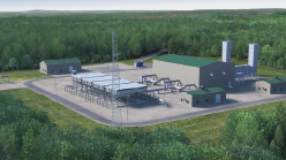There is now a broad consensus that there will be many nuclear plant shutdowns in the United States. For the first time, there is a need for serious supply-side response to the effect of nuclear plant shutdowns on regional U.S. energy supply.
Possible nuclear plant shutdowns provide a potential for up to 1.55 trillion cubic feet per year of natural gas as replacement for electricity generation, requiring further expansion of pipeline capacity in the Midwest and Northeast. Sixty-four percent of the projected new gas pipeline in the northern tier would be absorbed in the Northeast and Midwest to meet nuclear replacement requirements. This does not include natural gas-fired generation that would be needed to meet growth requirements or to replace coal or other existing generation.
Two companies-Northeast Utilities and Commonwealth Edison-which own the bulk of the nuclear generation in these two regions, are particularly likely to permanently shut down additional units. As a result, the Chicago area and New England may be the focal point for critical natural gas supply decisions.
In February 1997, the Washington International Energy Group prepared a report for the INGAA Foundation, Nuclear Power Plants and Implications of Early Shutdown for Future Natural Gas Demand. Since that study’s release, six nuclear units at five sites in the U.S. have been permanently shut down or have been slated for shutdown, and Ontario Hydro has closed seven nuclear units at two sites. It is unlikely that these units will be reopened.
The total amount of nuclear capacity being shut down is 8,800 megawatts, of which 6,700 MWe is in the northeastern market of the U.S. and Canada. The other 2,100 MWe is in the U.S. Midwest.
A competitive analysis of the remaining nuclear plants shows about 33,700 MWe of capacity vulnerable to shutdown. Together with those already slated for shutdown, there now is about 42,500 MWe representing 37 percent of the combined nuclear capacity of both the U.S. and Canada. The major findings of this year’s reanalysis of vulnerable nuclear plants compared to the 1997 study are:
- For the total Northeast, U.S. (New England, New York and the mid-Atlantic) and Canada, vulnerable capacity increased from nearly 14,000 MWe in the 1997 study to nearly 16,400 MWe in the current study, a 17 percent increase. It is not unlikely that nearly all nuclear plants in New England will be shutdown in the next few years.
- For the U.S. Midwest, MAIN and MNP NERC regions, consisting mainly of Illinois, Wisconsin, Minesota, Iowa, the Dakotas, and Nebraska, the increase is from about 8,900 MWe to nearly 11,000 MWe, a 23 percent increase.
- For the ECAR region, consisting mainly of Indiana, Kentucky, Michigan, Ohio, and West Virginia, about 7,400 MWe are vulnerable to shutdown, the same as in the 1997 study.
- For the remainder of the United States, about 7,700 MWe are vulnerable.
- For the North American gas pipeline industry, developments described in this report lend credence to the gas industry’s strategic decisions to expand in the Midwest and Northeast. These developments also mean a new burden for the gas industry- accelerated effort to site, finance and build new pipeline capacity and a de facto responsibility to be sure that the industry is ready to meet the new power generation requirements that are resulting from these nuclear plant closings.





